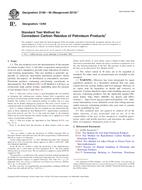Potrebujeme váš súhlas na využitie jednotlivých dát, aby sa vám okrem iného mohli ukazovať informácie týkajúce sa vašich záujmov. Súhlas udelíte kliknutím na tlačidlo „OK“.
ASTM D189-06(2010)e1
Standard Test Method for Conradson Carbon Residue of Petroleum Products (Includes all amendments And changes 11/14/2014).
Automaticky preložený názov:
Štandardná skúšobná metóda pre Conradsona Carbon zvyšok ropných produktov
NORMA vydaná dňa 15.11.2010
Informácie o norme:
Označenie normy: ASTM D189-06(2010)e1
Poznámka: NEPLATNÁ
Dátum vydania normy: 15.11.2010
Kód tovaru: NS-18671
Počet strán: 7
Približná hmotnosť: 21 g (0.05 libier)
Krajina: Americká technická norma
Kategória: Technické normy ASTM
Anotácia textu normy ASTM D189-06(2010)e1 :
Keywords:
Conradson carbon residue, lubricants, petroleum products, Burner fuel oils, Carbonaceous residue, Carbon residue (petroleum products), Coke-forming propensities, Conradson method, Fuel oils, Pyrolysis, Residue--petroleum products, ICS Number Code 75.080 (Petroleum products in general)
Doplňujúce informácie
| Significance and Use | ||||||||||||||||||
|
The carbon residue value of burner fuel serves as a rough approximation of the tendency of the fuel to form deposits in vaporizing pot-type and sleeve-type burners. Similarly, provided alkyl nitrates are absent (or if present, provided the test is performed on the base fuel without additive) the carbon residue of diesel fuel correlates approximately with combustion chamber deposits. The carbon residue value of motor oil, while at one time regarded as indicative of the amount of carbonaceous deposits a motor oil would form in the combustion chamber of an engine, is now considered to be of doubtful significance due to the presence of additives in many oils. For example, an ash-forming detergent additive may increase the carbon residue value of an oil yet will generally reduce its tendency to form deposits. The carbon residue value of gas oil is useful as a guide in the manufacture of gas from gas oil, while carbon residue values of crude oil residuums, cylinder and bright stocks, are useful in the manufacture of lubricants. |
||||||||||||||||||
| 1. Scope | ||||||||||||||||||
|
1.1 This test method covers the determination of the amount of carbon residue (Note 1) left after evaporation and pyrolysis of an oil, and is intended to provide some indication of relative coke-forming propensities. This test method is generally applicable to relatively nonvolatile petroleum products which partially decompose on distillation at atmospheric pressure. Petroleum products containing ash-forming constituents as determined by Test Method D482 or IP Method 4 will have an erroneously high carbon residue, depending upon the amount of ash formed (Note 2 and Note 4). Note 1—The term carbon residue is used throughout this test method to designate the carbonaceous residue formed after evaporation and pyrolysis of a petroleum product under the conditions specified in this test method. The residue is not composed entirely of carbon, but is a coke which can be further changed by pyrolysis. The term carbon residue is continued in this test method only in deference to its wide common usage. Note 2—Values obtained by this test method are not numerically the same as those obtained by Test Method D524. Approximate correlations have been derived (see Fig. X1.1), but need not apply to all materials which can be tested because the carbon residue test is applied to a wide variety of petroleum products. Note 3—The test results are equivalent to Test Method D4530, (see Fig. X1.2). Note 4—In diesel fuel, the presence of alkyl nitrates such as amyl nitrate, hexyl nitrate, or octyl nitrate causes a higher residue value than observed in untreated fuel, which can lead to erroneous conclusions as to the coke forming propensity of the fuel. The presence of alkyl nitrate in the fuel can be detected by Test Method D4046. 1.2 The values stated in SI units are to be regarded as standard. No other units of measurement are included in this standard. 1.3 WARNINGMercury has been designated by many regulatory agencies as a hazardous material that can cause central nervous system, kidney and liver damage. Mercury, or its vapor, may be hazardous to health and corrosive to materials. Caution should be taken when handling mercury and mercury containing products. See the applicable product Material Safety Data Sheet (MSDS) for details and EPA’s website http://www.epa.gov/mercury/faq.htmfor additional information. Users should be aware that selling mercury and/or mercury containing products into your state or country may be prohibited by law. 1.4 This standard does not purport to address all of the safety concerns, if any, associated with its use. It is the responsibility of the user of this standard to establish appropriate safety and health practices and determine the applicability of regulatory limitations prior to use. |
||||||||||||||||||
| 2. Referenced Documents | ||||||||||||||||||
|




 Cookies
Cookies
